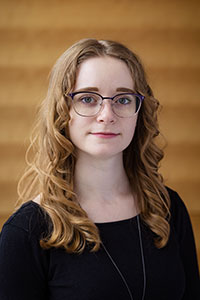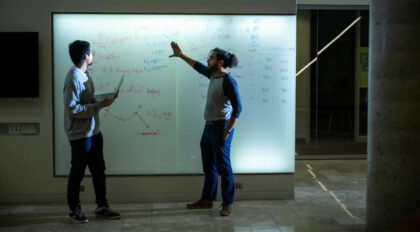Metabolism researcher pursues hard questions, creative solutions with special cell culture media
During the long months of COVID-19 shutdown, Kim Huggler found particular joy in her one in-lab task each week – calibrating the mass spectrometer.
At first, Huggler, a sixth-year doctoral student and graduate research assistant in the Cantor Lab, used the time to prepare for her preliminary exam. But with the exam in the rear-view mirror, days grew long and tiresome.

“That was rough. I don’t remember much because every day was the same,” Huggler says. “I got special access to do the calibration each week. I could at least see a place that was not my apartment. A lot of science is just being able to talk about it with fellow scientists and being surrounded by hardworking people.”
Much of what Huggler missed was the creativity of science. While some may believe that science is bound by rigid rules, she knows that creation and innovation are the fuel of scientific discovery.
“The questions people are asking in science aren’t easy. If they were easy, they’d be answered,” she says. “Hard questions mean that you have to come up with creative solutions.”
And while Morgridge scientists are armed with the best in technology, those machines and techniques have limitations.
“We have to figure out ways to push the technology in ways that people haven’t thought about,” Huggler says. “And coming up with creative ideas to explain your results is also important. Coming up with hypotheses and testing them is a big part of the process.”
Huggler, the daughter of a physician and a lawyer, was drawn to science as a child in Pittsburgh. That interest was cemented in a high school advanced placement biology class and led her to get a bachelor’s degree in biochemistry at Denison University in Ohio in 2017.
She believed that undergraduate research work in physical chemistry and a stint as an undergraduate teaching assistant would help prepare her for medical school, but late in her undergraduate career, her advisors suggested that graduate school would be another option.
Ultimately, she went with the University of Wisconsin–Madison’s Integrated Program in Biochemistry and became fascinated with Morgridge Investigator and UW–Madison professor of biochemistry Jason Cantor’s work in studying how environmental factors impact cell physiology.
Much of the understanding of human cell biology is based on cell culture models. But those models largely use culture media that don’t reflect conditions in the human body. The cells are fed a rich cocktail of nutrients like sugars and amino acids, and this affects their behavior.
Cantor designed a cell culture medium that models the metabolite concentrations of average human plasma.
“Can this cell culture medium reveal new or unforeseen aspects of biology?” asked Huggler. “It might show how cancer cells can be treated. We want to improve cell culture models so that we give cancer treatments the best chance to succeed at the next phase of development.”
Huggler hopes to use her experience and doctorate to obtain a research job in government or private industry. Partly because of pandemic disruptions, Huggler still has about a year of graduate work remaining.
But she is grateful for the chance to immerse herself in the science and collaborate with colleagues.
“I feel a lot more confident in my ability to just do science and come up with questions and experiments to address those questions,” she says.

Rising Sparks: Early Career Stars
Rising Sparks is a monthly profile series exploring the personal inspirations and professional goals of early-career scientists at the Morgridge Institute.
